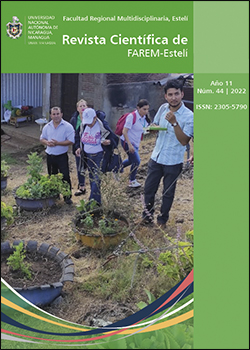Adoption of water resources technologies and climate change adaptation measures in the Aguas Calientes Sub-basin, Madriz 2022
DOI:
https://doi.org/10.5377/farem.v11i44.15691Keywords:
Technologies, adaptation measures, sub-basin, water resources, climate changeAbstract
Water is an indispensable resource to maintain the life of natural ecosystems; as well as the productive activities that guarantee resources for humans. Adaptation to climate change is a fundamental factor to consider in the different initiatives of productive development and Integrated Water Resources Management (IWRM). The objective of this research was to describe the process of adoption of technologies and adaptation measures for the use and development of water to reduce the negative impacts of climate change in producing families in the NSC. The study is descriptive and cross-sectional in nature, applying qualitative methods such as: focus group discussions, semi-structured interviews and participant observation. The results indicate that 3 adaptation measures and 14 types of water resources technologies have been implemented, distributed as follows: 3 rainwater harvesting, 7 runoff water retention and storage and 4 water optimization-reuse. The process began with the collection of relevant primary and secondary information from key stakeholders and field visits to identify the technologies in the area. It was concluded that rainwater harvesting technologies have been the most effective in the upper and middle zones of the sub-basin, but runoff water retention and storage technologies have not been very efficient due to the conditions of the terrain, and water optimization-reuse technologies are little used. On the other hand, the community members consider the economic and environmental costs they represent to be important.
Downloads
References
Cajina, M. (2006). Alternativas de captación de agua en la subcuenca del río Aguas Calientes para mejorar los beneficios socioeconómicos y ambientales de las comunidades de los municipios de Somoto y San Lucas, Nicaragua. Turrialba, CR, CATIE.
Calderón, H. (2016). Retos en la evaluación de recursos hídricos en cuencas pobremente aforadas, la situación de Nicaragua y Centroamérica. Revista Científica Agua y Conocimiento, 2(1), 49–64. Recuperado a partir de https://revistacira.unan.edu.ni/index.php/AyC/article/view/48
Castillo Hernández, E. and Calderón Palma, Heyddy and Delgado Quezada, Valeria and Flores Meza, Yelva and Salvatierra Suárez, Thelma (2006) Situación de los recursos hídricos en Nicaragua. Boletín Geológico y Minero, 117 (1). pp. 127-146.
Champalle, C., Ford, J., & Sherman, M. (2015). Prioritizing Climate Change Adaptations in Canadian Arctic Communities. Sustainability, 7. https://doi.org/10.3390/su7079268
Elliott, M., Armstrong, A., Lobuglio, J., & Bartram, J. ( 2011). Tecnologías de Adaptación al Cambio Climático-Sector de Recursos Hídricos. Cochabamba, Bolivia: UNEP.
FAO. (2016). Día Mundial del Agua 2016. Usos a nivel agrícola ganadero. Roma, Italia. Obtenido de https://diamundialdelagua2016.wordpress.com.
Global Water Partnership, GWP. (2013). Tecnologías para el Uso sostenible del Agua: Una contribución a la seguridad alimentaria y la adaptación al cambio climático. Tegucigalpa, Honduras.
Hernández Sampieri, R., Fernández Collado, C., & Baptista Lucio, M. d. (1991). Metodología de la investigación. México D.F: McGRAW-HILL / INTERAMERICANA EDITORES, S.A. DE C.V.
Intergovernmental Panel on Climate Change, IPCC. (2022). Climate Change 2022 Impacts, Adaptation and Vulnerability. Working Group II Contribution to the Sixth Assessment Report of the Intergovernmental Panel on Climate Change. Switzerland.
LEY N°. 722. Ley Especial de los Comités de Agua Potable y Saneamiento. (19 de Mayo de 2010). Obtenido de http://legislacion.asamblea.gob.ni/Normaweb.nsf/3133c0d121ea3897062568a1005e0f89/a63305b993cddb210625775f0069e8b3Lorío Berríos, A. L., Prins, C., & Francisco, J. (2005). Organización, regulación y tecnologías para el manejo y conservación del recurso hídrico en la subcuenca del Río Aguas Caliente, Nicaragua. San José C.R: Recursos Naturales y Ambiente.
MARENA. (2017). Estudio de tecnologías de adaptación al Cambio Climático en Sectores priorizados. Managua, Nicaragua.
Milán, J. (2012). Apuntes sobre el cambio climático en Nicaragua. Managua.
Mola Fines, B. B. (2021). Tecnologías para el uso eficiente de los recursos hídricos en fincas ganaderas. Revista Ingeniería Agrícola. Obtenido de https://revistas.unah.edu.cu/index.php/IAgric/article/view/1401/2553.
Taeihagh, A., Givoni, M., & Bañares-Alcántara, R. (2013). Which policy first? A network centric approach for the analysis and ranking of policy measures. Environment and Planning B: Planning and Design, 40, 595 – 616.
Published
Issue
Section
License
Copyright (c) 2023 Revista Científica de FAREM-Esteli

This work is licensed under a Creative Commons Attribution-NonCommercial-ShareAlike 4.0 International License.



